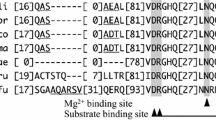Abstract
Efficient degradation of cellulose needs a synergistic reaction of the cellulolytic enzymes, which include exoglucanases, endoglucanases, and β-1,4-glucosidase. In this study, we used an improved Bac-to-Bac/BmNPV baculovirus expression system, which lacks the virus-encoded chitinase cathepsin (v-cath) genes of Bombyx mori nucleopolyhedrovirus (BmNPV), to express the endoglucanase V (EG V) gene from Trichoderma viride in silkworm BmN cells and silkworm larvae, and analyzed the characteristics of the recombinant enzyme in silkworm larvae. The result showed that an around 36-kDa protein was visualized in BmN cells at 48 h after the second-generation recombinant mBacmid/BmNPV/EG V baculovirus infection. The crude enzyme extract from the recombinant baculoviruses-infected silkworms exhibited a significant maximum activity at the environmental condition of pH 5.0 and a temperature of 50 °C, and increased 39.86% and 37.76% compared with that from blank mBacmid/BmNPV baculovirus-infected silkworms and normal silkworms, respectively. It was stable at pH range from 5.0 to 10.0 and at temperature range from 40 to 60 °C. The availability of large quantities of EG V that the silkworm provides might greatly facilitate the future research and the potential application in industries.




Similar content being viewed by others

References
Yamada, R., Taniguchi, N., Tanaka, T., Ogino, C., Fukuda, H., & Kondo, A. (2010). Cocktail delta-integration: a novel method to construct cellulolytic enzyme expression ratio-optimized yeast strains. Microb Cell Fact, 9, 32.
Wilson DB, Irwin DC, (1999) Genetics and properties of cellulases. In: Advances in Biochemical Engineering / Biotechnology: Recent Progress in Bioconversion vol 65. Springer-Verlag, Berlin pp 1–21
Beguin, P., & Aubert, J. P. (1994). The biological degradation of cellulose. FEMS Microbiology Reviews, 13, 25–58.
Watanabe, H., & Tokuda, G. (2001). Animal cellulases. Cellular and Molecular Life Sciences, 58, 1167–1178.
Davison, A., & Blaxter, M. (2005). Ancient origin of glycosyl hydrolase family 9 cellulase genes. Molecular Biology and Evolution, 22, 1273–1284.
Penttila, M., Lehtovaara, P., Nevalainen, H., Bhikhabhai, R., & Knowles, J. (1986). Homology between cellulase genes of Trichoderma reesei: complete nucleotide sequence of the endoglucanase I gene. Gene, 45, 253–263.
Tomme, P., Van Tilbeurgh, H., Pettersson, G., Van Damme, J., Vandekerckhove, J., Knowles, J., et al. (1988). Studies of the cellulolytic system of Trichoderma reesei QM 9414. Analysis of domain function in two cellobiohydrolases by limited proteolysis. European Journal of Biochemistry, 170, 575–581.
Miettinen-Oinonen, A., & Suominen, P. (2002). Enhanced production of Trichoderma reesei endoglucanases and use of the new cellulase preparations in producing the stonewashed effect on denim fabric. Applied and Environmental Microbiology, 68, 3956–3964.
Wu, S., Ding, S., Zhou, R., & Li, Z. (2007). Comparative characterization of a recombinant Volvariella volvacea endoglucanase I (EG1) with its truncated catalytic core (EG1-CM), and their impact on the bio-treatment of cellulose-based fabrics. Journal of Biotechnology, 130, 364–369.
Miyajima, A., Schreurs, J., Otsu, K., Kondo, A., Arai, K., & Maeda, S. (1987). Use of the silkworm, Bombyx mori, and an insect baculovirus vector for high-level expression and secretion of biologically active mouse interleukin-3. Gene, 58, 273–281.
Lee, K. S., Je, Y. H., Woo, S. D., Sohn, H. D., & Jin, B. R. (2006). Production of a cellulase in silkworm larvae using a recombinant Bombyx mori nucleopolyhedrovirus lacking the virus-encoded chitinase and cathepsin genes. Biotechnological Letters, 28, 645–650.
Li, Xing-hua, Wang, D., Zhou, F., Yang, Hua-jun, Bhaskar, R., Jia-biao, Hu, et al. (2010). Cloning and expression of a cellulase gene in the silkworm, Bombyx mori by improved Bac-to-Bac/BmNPV baculovirus expression system. Molecular Biology Reports, 37, 3721–3728.
Lin, Y., & Tanaka, S. (2006). Ethanol fermentation from biomass resources: current state and prospects. Applied Microbiology and Biotechnology, 69, 627–642.
Maeda, S. (1994). Expression of foreign genes in insect cells using baculovirus vectors. In K. Maramorosch & A. H. McIntosh (Eds.), Insect cell biotechnology (pp. 1–31). Boca Raton: CRC Press.
Jeefrey, L. C., & Charles, S. C. (1996). Insect cell expression technology. In J. L. Cleland & C. S. Craik (Eds.), Protein engineering (pp. 183–218). New York: Wiley-Liss Press.
Choudary, P. V., Kamita, S. G., & Maeda, S. (1995). Expression of foreign genes in Bombyx mori larvae using baculovirus vectors. In C. D. Richardson (Ed.), Methods in molecular biology. Baculovirus expression protocols, vol. 39. New Jersey: Humana.
Li, S., Ip, D. T., Lin, H. Q., Liu, J. M., Miao, Y. G., Ke, L. J., et al. (2010). High-level expression of functional recombinant human butyrylcholinesterase in silkworm larvae by Bac-to-Bac System. Chemico-biological interactions, 187(1–3), 101–5105.
Zhao, Y., Li, X., Cao, G., Xue, R., & Gong, C. (2009). Expression of hIGF-I in the silk glands of transgenic silkworms and in transformed silkworm cells. Science in China. Series C: Life Sciences, 52, 1131–1139.
Liu, J. M., David, Wan Chi Cheong, Ip, Denis Tsz-Ming, Li, Xing-hua, Li, Guang-li, Xiao-feng, Wu, et al. (2009). High-level expression of orange fluorescent protein in the silkworm larvae by the Bac-to-Bac system. Molecular Biology Reports, 36, 329–335.
Tang, B., Pan, H., Zhang, Q., & Ding, L. (2009). Cloning and expression of cellulase gene EG1 from Rhizopus stolonifer var. reflexus TP-02 in Escherichia coli. Bioresource Technology, 100, 6129–6132.
van Wyk, N., den Haan, R., & van Zyl, W. H. (2010). Heterologous co-production of Thermobifida fusca Cel9A with other cellulases in Saccharomyces cerevisiae. Applied Microbiology and Biotechnology. doi:10.1007/s00253-00010-02618-z.
Acknowledgments
This work was supported by the National Natural Science Foundation of China (no. 30972141/C120110) and the Chinese Universities Scientific Fund.
Author information
Authors and Affiliations
Corresponding author
Rights and permissions
About this article
Cite this article
Li, Xh., Wang, Mx., Zhang, P. et al. Heterologous Expression Characteristics of Trichoderma viride Endoglucanase V in the Silkworm, Bombyx mori L.. Appl Biochem Biotechnol 165, 728–736 (2011). https://doi.org/10.1007/s12010-011-9291-2
Received:
Accepted:
Published:
Issue Date:
DOI: https://doi.org/10.1007/s12010-011-9291-2



